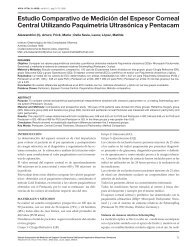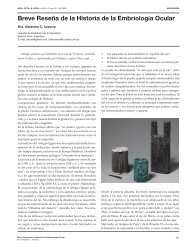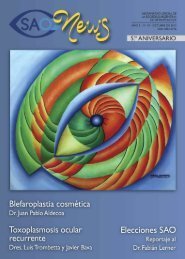Volumen 79 Número 1 - Sociedad Argentina de Oftalmología
Volumen 79 Número 1 - Sociedad Argentina de Oftalmología
Volumen 79 Número 1 - Sociedad Argentina de Oftalmología
You also want an ePaper? Increase the reach of your titles
YUMPU automatically turns print PDFs into web optimized ePapers that Google loves.
Luengo Gimeno, Fe<strong>de</strong>rico<br />
ABSTRACT<br />
ALLOGRAFT EPITHELIAL CORNEAL CELL LAYERS TRANSPLANTATION IN RABBITS<br />
Objective: To evaluate the efficacy of heterologous limbal cell sheet transplantatation over time.<br />
Methods: Limbal stem cell <strong>de</strong>ficiency (LSCD) was induced in 1 New Zealand White rabbits by alkaline<br />
injury (autologous group) and in 20 animals by anterior lamellar keratectomy including the limbal area<br />
(heterologous group). A small 2. mm2 limbal sample was obtained from healthy eyes of randomly<br />
selected rabbits. Limbal epithelial cells were cultured on a fibroblast fee<strong>de</strong>r layer grown on autologous<br />
clotted platelet poor plasma (PPP), and 21 days later stratified epithelial sheets were ready to be grafted.<br />
The heterologous epithelial grafts were sutured over the exposed corneal stroma. Clinical follow up was<br />
performed for up to 360 days.<br />
Results: Clinically the corneas were clear from the 21 st postoperative day in all animals. No neovascularization<br />
was seen in the autologous group. A full thickness continuous layer of stratified epithelial cells resembling<br />
corneal epithelium was seen in grafted corneas of the heterologous group. Control group showed a thin<br />
regenerative epithelium and a pronounced fibroblastic proliferation. Neither clinical nor histological<br />
evi<strong>de</strong>nce of immune reaction was observed.<br />
Conclusions: Auto and allografts of bioengineered limbal epithelium promoted corneal reepithelialization.<br />
These results could be consi<strong>de</strong>red as a beneficial option for uni or bilateral ocular surface diseases<br />
treatment.<br />
Key Words: stem cells, timbal cell déficit, bioengineerigng, alkalis.<br />
[ 14 ]<br />
Introducción<br />
Actualmente, la bioingeniería <strong>de</strong> tejidos se ha establecido<br />
como una opción terapéutica en diversos<br />
campos <strong>de</strong> la medicina. Los avances biotecnológicos<br />
han permitido el cultivo y replicación<br />
<strong>de</strong> células pluripotenciales <strong>de</strong> algunos órganos,<br />
como mioblastos, condroblastos, células madre<br />
<strong>de</strong> médula ósea y queratinocitos <strong>de</strong> piel. Esto ha<br />
permitido <strong>de</strong>sarrollar nuevas terapias <strong>de</strong> transplante<br />
<strong>de</strong> tejidos en pacientes que no tenían,<br />
tiempo atrás, posibilida<strong>de</strong>s <strong>de</strong> recibir algún tipo<br />
<strong>de</strong> tratamiento. A estos avances se sumó el transplante<br />
<strong>de</strong> epitelio corneal a partir <strong>de</strong> las células<br />
madre <strong>de</strong>l limbo esclerocorneal. 1-3<br />
El transplante autólogo <strong>de</strong> células troncales<br />
limbares <strong>de</strong> epitelio corneal es una opción<br />
terapéutica. 4 Se ha establecido como opción te-<br />
rapéutica en patologías <strong>de</strong> la superficie corneal<br />
como quemaduras por álcalis, síndrome <strong>de</strong> Stevens-Johnson,<br />
6 penfigoi<strong>de</strong> ocular 7 y pterigion gigante,<br />
don<strong>de</strong> procesos secundarios a un Déficit<br />
<strong>de</strong> Stem Cells Limbares (DSCL) - como la presencia<br />
<strong>de</strong> vasos sanguíneos invadiendo la cornea 8-9<br />
más una histoarquitectura corneal anormal-,<br />
conllevan a una pérdida total <strong>de</strong> la transparencia<br />
<strong>de</strong> ese órgano, causando una ceguera invalidante<br />
en el paciente. 10<br />
Los objetivos <strong>de</strong> nuestro estudio fueron lograr<br />
el cultivo <strong>de</strong> una neomembrana <strong>de</strong> epitelio<br />
corneal a partir <strong>de</strong> una mínima muestra <strong>de</strong> células<br />
troncales limbares 11 y que ésta sea efectiva<br />
en el tratamiento <strong>de</strong> alteraciones <strong>de</strong> la superficie<br />
corneal <strong>de</strong> conejos, autólogos o heterólogos, con<br />
déficit <strong>de</strong> células troncales limbares.






